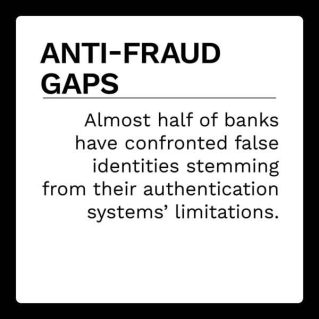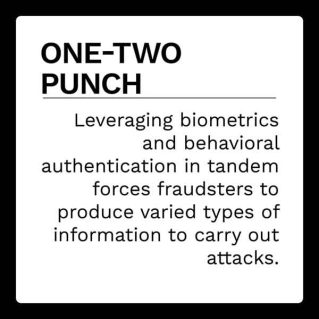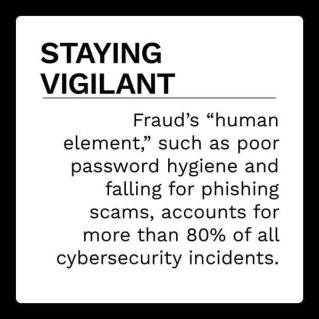Fraudsters are growing bolder in their tactics and targets, and fraud prevention experts struggle to keep up. Banks, for example, saw their average monthly volume of fraud attacks increase from 1,977 in 2020 to 2,320 in 2021. Fraudsters have been hard at work exploiting every possible flaw in companies’ and customers’ armor, deploying identity theft, card-not-present fraud, account takeovers, malware and friendly fraud, among many other techniques.
Biometrics is one popular choice for fraud prevention, as well as multifactor  authentication, anomaly detection and several other solutions. Each one has security loopholes that fraudsters can detect and exploit, however, making each option ineffective as a one-size-fits-all solution. Instead, organizations should look to multilayered defense systems that include behavioral analytics. A fraudster that managed to spoof a user image or intercept a verification code would still have to enter in the false data they acquired, allowing the analytics system to ping them as an illegitimate user by identifying their typing patterns as those of a bad actor rather than a legitimate user.
authentication, anomaly detection and several other solutions. Each one has security loopholes that fraudsters can detect and exploit, however, making each option ineffective as a one-size-fits-all solution. Instead, organizations should look to multilayered defense systems that include behavioral analytics. A fraudster that managed to spoof a user image or intercept a verification code would still have to enter in the false data they acquired, allowing the analytics system to ping them as an illegitimate user by identifying their typing patterns as those of a bad actor rather than a legitimate user.
The February Monetizing Digital Intent Tracker®: Using Behavior As A Service To Drive Top-Line Growth explores the latest in the world of behavioral analytics, including the growing fraud threats facing organizations, the use of behavioral analytics as part of multilayered security stacks and how these analytics can improve the customer experience across the board.
Developments From the Behavioral Analytics World
Knowledge-based authentication (KBA) methods can be highly vulnerable to data breaches, potentially leaking vast sums of personal login credentials into cyberspace for opportunistic fraudsters to collect and sell them to other bad actors. The U.K. National Crime Agency’s National Cyber Crime Unit recently discovered a motherlode of stolen credentials, including more than 586 million sets of usernames, passwords and other details for fraudsters to leverage in credential stuffing attacks. According to watchdog website Have I Been Pwned, 226 million of the credentials had never been seen before, meaning that hundreds of millions of individuals are now vulnerable to fraud.
 Most security systems still have one major flaw: the vigilance of their users. A recent study found that 85% of cybersecurity incidents stemmed from the “human element,” such as employees falling for phishing scams, poor password hygiene or improper use of security systems. Another survey backed up this finding by reporting that 61% of respondents failed a quiz on cybersecurity fundamentals. More vigilant employee training regarding phishing scam awareness and personal device restrictions could help address these flaws, but companies typically spend just 5% of their IT budgets on this. Another option could be increased reliance on automated security systems, like behavioral analytics, that remove the human element entirely.
Most security systems still have one major flaw: the vigilance of their users. A recent study found that 85% of cybersecurity incidents stemmed from the “human element,” such as employees falling for phishing scams, poor password hygiene or improper use of security systems. Another survey backed up this finding by reporting that 61% of respondents failed a quiz on cybersecurity fundamentals. More vigilant employee training regarding phishing scam awareness and personal device restrictions could help address these flaws, but companies typically spend just 5% of their IT budgets on this. Another option could be increased reliance on automated security systems, like behavioral analytics, that remove the human element entirely.
For more on these and other behavioral analytics news items, download this month’s Tracker.
Alloy on Leveraging Behavioral Analytics as Part of a Multilayered Defense System
Fraudsters are incredibly creative in their tactics, making one-size-fits-all security solutions hopelessly ineffective. Instead, companies are deploying multilayered solutions to protect their customers with plenty of overlap and redundancies.
In this month’s Feature Story, PYMNTS talked with Harris Chen, senior product manager at identity decisioning platform Alloy, about how behavioral analytics can play an integral role in these multilayered fraud prevention protocols.
PYMNTS Intelligence: The Advantages Of Behavioral Analytics in Multifaceted Security Stacks
 Bad actors deploy a wide variety of methods to stage account fraud, so organizations’ defenses should be no less diverse. Behavioral analytics can form an integral part of multilayered security systems, operating as a second line of defense after customers have been authenticated via biometrics, multifactor authentication or some other method at the point of entry.
Bad actors deploy a wide variety of methods to stage account fraud, so organizations’ defenses should be no less diverse. Behavioral analytics can form an integral part of multilayered security systems, operating as a second line of defense after customers have been authenticated via biometrics, multifactor authentication or some other method at the point of entry.
In this month’s PYMNTS Intelligence, PYMNTS explores the challenges organizations face in one-size-fits-all cybersecurity protocols and how behavioral analytics can integrate into a multilayered fraud prevention system.
About the Tracker
The Monetizing Digital Intent Tracker®: Using Behavior As A Service To Drive Top-Line Growth, a PYMNTS and Neuro-ID collaboration, is the go-to monthly resource for updates on trends and changes in behavioral analytics.

